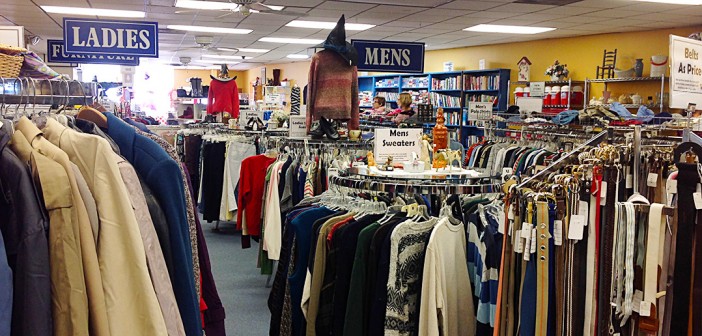The thrift store is humming with activity.
Patrons mill around between racks full of colorful clothes, tables of ceramic knickknacks and shelves piled high with well-worn books. Children busy themselves in the corner with plastic toy trucks and a stand filled with board games. Music plays quietly in the background as the customers fill plastic shopping bags to the point of overflowing.
The Via Fountain Hill store is having a Fill the Bag Sale, and it’s everything you can fit for $15.
But in the corner of an adjacent room is an item of particular value, and it’s not for sale.
It’s a poster board that displays Via of the Lehigh Valley Inc.’s mission statement along with photos of those who benefit from the nonprofit’s services — the mentally disabled individuals the organization calls “consumers.” The thrift enterprise, which is comprised of five stores all throughout the valley, is one way Via funds resources that include living support, employment and mentoring opportunities, among initiatives.
As for the board, it’s meant to show people to whom and to what their business contributes.
“Not everybody knows what Via does when they walk in the door,” said Jillian Lovejoy, Via’s director of communications and development. “But I think after they leave, they do. And that’s something that keeps them coming back.”
The board — and Via itself — are about community engagement, and have been since the thrift aspect began in the 1970s. Back then, parents of Via consumers volunteered their time to acquire donations and sell secondhand goods. Now the stores have employees, some able-bodied and some who live with a disability.
Gerry Yasso, Via’s vice president of resource development, oversees the thrift operation and has been with the organization for nine years. In that time, he’s seen the number of stores — and popularity of thrift — grow.
But the core of the operation, he said, has always been community donation.
“There are hundreds and hundreds of donations made by (the Lehigh Valley) community weekly,” he said. “Oftentimes, our donation shed is just packed.”
These donations aren’t limited in variety, either. At the Fountain Hill store, a sprawling basement and spare rooms are filled with glossy wood furniture. Walls are covered in seemingly endless shoe racks, as well as pieces of art. There are clothes hangers filled with feathery, sequined Halloween costumes and a telescope that sits as a centerpiece on a shelf.
There is quite a selection, and the magnitude of this generosity can be linked to the thrift store’s local outreach. Unlike nationally ubiquitous thrift operations such as Good Will or the Salvation Army, Via’s stores have roots in the surrounding community.
That’s what Lovejoy said makes them so special.
“We’re talking about helping the local economy,” she said. “We’re talking about helping a vulnerable population. It’s all really local, and I think that’s important to people.”
While that helping is at the center of Via’s mission, and supporting its consumers are the organization’s main focus, Yasso said the group will “often have a broader mission at crucial times.”
In the City of Bethlehem, 19.7 percent of the population is living below the poverty line, according to a 2013 survey conducted by the U.S. Census Bureau. Located in the city’s suburb, the Fountain Hill store is a nearby source for affordable goods.
There are school supplies, dishes, blankets as well as hats and gloves for the impending winter months. The Via thrift stores can offer necessities just as they can eclectic pieces.
And for some in the community, thrift is the option, Yasso said. He thinks it’s a fact to be sensitive about.
“In any venture like (the thrift stores), you’re going to have forays into other missions,” he said. “One of those forays is getting into supporting families of socioeconomic disadvantage.”
With their offerings, Via stores are equipped to fulfill that mission. But the stores have more sides to them than just the business one. Mark Kolesar, the thrift director, has been with Via for little over a month but has realized this quickly.
Kolesar works on thrift initiatives, like the bag sale, and understands when people head to the stores, they’re looking for deals. But he said it’s vocalizing the organization’s mission that brings a customer the added value of contributing to a cause.
“It’s key to engage the community, and let them know what is happening directly in their community, and what they impact directly or indirectly,” he said.
Kolesar can recall a moment at the Via center when a consumer approached him in a hallway and offered her hand. He took it into his and, together, they walked to her next destination.
This is why the poster board exists. There are people behind the products displayed in the thrift stores — people who are fulfilling their “full potential” as Via’s mission intends.
They’re also people who are part of a community. Directors and consumers know each other’s names. They share workspace and greet each other in the mornings. Sometimes, consumers come to the Fountain Hill store to test their skills by working the register.
Joyce Weed, the store’s assistant manager, works to ensure that customers know their impact. She can see firsthand how customers respond to Via’s mission, and the idea of helping consumers in their own community.
It’s what makes people go out of their way to donate, she said.
“We get customers who are here for the first time, and I tell them our mission, and they really like that information,” she said. “They say, ‘Oh, well I’ll be back.’”
And Weed can attest, they are.






Comment policy
Comments posted to The Brown and White website are reviewed by a moderator before being approved. Incendiary speech or harassing language, including comments targeted at individuals, may be deemed unacceptable and not published. Spam and other soliciting will also be declined.
The Brown and White also reserves the right to not publish entirely anonymous comments.